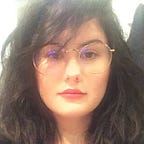Step 2 : How to research and build a Bibliography
As I started writing a book about Invisual Art (you will find more about this topic in my previous article) I decided to share my research methodology with those who would like to embark on a similar project. Such as Plato, my idea of a perfect world would be a place inhabited only by researchers 😻
So moving from nerdy jokes to real facts about how to create a bibliography, which will support the whole process of research and the paper itself, I would divide this step into two main stages: Research for similar papers, books, thesis etc. and Layout.
But first I would like to explain why the bibliography comes second when paradoxically it appears at the end of the book. Well it is quite simple: the bibliography sustains the entire project, it is a massive database containing the information you will develop into a thesis. So naturally all files must be gathered in the beginning of the research process, because in order to start a research you must have a well defined research area.
Also it is very important to give the references of each consulted text, either you are quoting it, making reference to it or the text just served as additional reading. (I think we can all agree that copyright can be a nightmare 🤨)
- 🔎 Research for similar papers, books, thesis etc.
a) Predictable, and yet start with a simple research on Google for example, by typing the key-words of your topic, and write down the most relevant titles you find.
⚠️Remember that if Google gives you already uncountable results, maybe your subject is too mainstream or overrated and you don’t want to be on the wave you want to be the wave itself.⚠️
If there is no info whatsoever about your topic, just relax the universe is not against you. It’s even better, that is good news because you can be sure that your thesis is unique. The bad news is that you have to construct the whole project by yourself counting exclusively on your brilliant mind. Good luck with that!
Continue with a tour on Google scholar.
⚠ ️ Keep in mind that other search engines, maybe more appropriate for this kind of project, exist, such as:
->Base (Bielefeld Academic Search Engine)
->BioText => research papers in the biology field.
->JURN => art, humanities, social etc.
->Science (I think the name speaks for itself)
->CiteSerX => computer science engin research
(Of course this is not an exhaustive list)
Also you can visit the platforms that list PhDs, master thesis and research papers, because there is the place where all the magic happens. You can see down below a few links where you can find this information, but remember that every country has such a platform in its own language, so just type “online thesis/masters” in the engine research and knock yourself out.
b) Once you have gathered the papers and books, thanks to the point a, you have to examine the bibliography of each text (as in the diagram below), this will give you the opportunity to extend your own bibliography, and you can continue on doing this with every source you add (I know it’s quite a pickle to go on this endless road, but good things happen to good people, and the satisfaction of a well done work is worth it ).
2. 📝 Layout
Typing the references is a long and boring process, but if you’re a purist you can do it manually by looking at the patterns used in usual bibliographies.
If you’re not a fan of this manual process, you can use online editing such as:
- http://www.citethisforme.com/ (a ISBN later you’ve got everything you need)
- or you can use Word to generate it, as you can see it in the video below: https://www.youtube.com/watch?v=EaTg2jOdbLE
You can choose to organise your references either by theme, or by the nature of the writing (article, phd thesis, books etc.), and even alphabetically if you have a short bibliography. Here you have an example of a manually typed bibliography.
Everything gravitates around the bibliography that comes at the the end of the book, and it’s supposed to say “Hey, I’ve got all the knowledge in the world about this topic”. So the more, the better. List everything you find: books, videos, articles, podcasts etc., every source is an indicator of your hard work, and by extension, of your expertise.
I hope you found this article useful, if you did, don’t hesitate to push the “Claps” button and to stay tuned, ‘cause more articles are on their way 😎.
